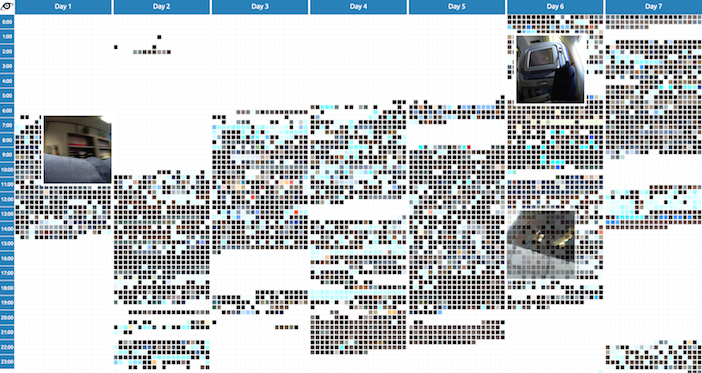The Colour of Life | Lifelogging Part One
LifeLogging is the subject of the current exhibition in the Science Gallery Dublin, which explores the way in which we can use data logging to track and improve our lives. Over the next few weeks we here at HeadStuff will be exploring aspects of data and life logging.
As part of the exhibition Insight Centre for Data Analytics are running a number of talks and open labs. In one such panel discussion Cathal Gurrin spoke about his experience with a wearable camera. The camera runs continuously and automatically takes a photo every minute. The camera Gurrin wears doesn’t look particularly sleek but he says that the next incarnation of Google Glass or possibly the new Sony SmartEyeGlass will be the way this technology is incorporated into our lives. Gurrin said he sees the thousands of photographs as data sets and the purpose of the research is to develop software that can interpret and sort through this mass data for useful insights into the habits and life of the wearer. It could help the wearer in day-to-day life, for example, where did you park your car? Did you like this bottle of wine? Did you remember to lock the back door? You will never forget anything unless you want to. This type of technology is already being used to provide Alzheimer’s patient support in the United Kingdom.
A typical day recorded on Gurrin’s wearable camera looks like this:
[youtube id=”_D7FhnnKJ2g” align=”center” autoplay=”no” maxwidth=”750″]
The data can be correlated with other sensory devices such as heart and stress rate monitors, GPS, or financial data. The software could automatically track your food and caffeine intake and your productivity levels and alert you when you need to replenish. Graham Healy, also working in the Insight centre, combines EEG monitoring and eye-tracking to pick out meaning in streams of fast moving images. In the future EEG data could be integrated into the life logging analysis software being developed. The potential in this technology is enormous. The feedback could create a perfect autobiographical memory, inform better health and financial decisions, and change how we work and love and live.
People have used pen and paper diaries for centuries for self-improvement. Digital life logging can bring it to a whole new level. On the mass scale this type of technology could detect population health patterns and public health threats, identify public hazards such as broken pavements and fix problems before they grow. In the not so distance future wearable devices will be replaced with implants and nano-detectors that can detect and prevent cancers or other problems on a realtime basis. The camera points outward to the world and therefore security and privacy are huge concerns in this line of work. It was suggested that the data gathered would not be available to the user in its raw form due to privacy risks and that individuals in the photos would have to give consent. Safely storing the images is another major challenge. One suggestion was the possibility that if the technology were allowed to advance, in the future the information could be automatically transmitted to the brain. That type of technology only exists in science fiction right now so in the meantime, faces are automatically blurred in photos unless consent is given, and heavy encryption and protection will be necessary when the software they are developing is to become a public product.

‘The Colour of Life’ wall reveals the patterns of colours we encounter in life captured by the wearable camera and is featured in the Science Gallery Dublin exhibition, which runs until April 17th 2015.
